7 days of Fun in Alexandria - mermaid of the
Mediterranean
Through a history of more than 2300 years, Alexandria has
played an important role in promoting art, culture and
science to the world. Since its establishment in 331 BCE,
Alexandria has been a symbol of beauty as it was nicknamed
by Egyptians "Mermaid of the Mediterranean". Alexandria was
named after Alexander the Great who built it to be the
capital of Egypt until the Islamic conquest in 642 A.D.
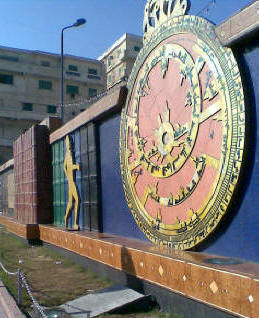 |
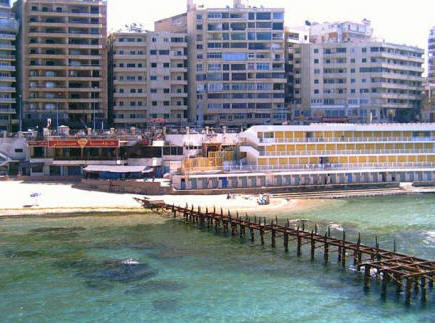 |
Arts on a wall in Alexandria
Photo taken in Azarita |
A view of one of Alexandria beaches with white sand
and turquoise blue water. |
Alexandria was built by Alexander the Great in 331 BCE
and was named after him. Dinocrates was the chief architect
for the project. Alexandria was intended to supersede
Naucratis as a Hellenistic centre in Egypt, and to be the
bridge between Greece and the rich Nile Valley. A small
Egyptian town, Rhakotis, which has already existed on the
Egyptian north Mediterranean shores continued to exist as
the Egyptian quarter of the city. A few months after its
establishment, Alexander left Egypt for the East and never
returned to Alexandria.
Alexandria became the centre of the new commerce between
Europe and the Arabian and Indian East, the city grew in
less than a generation to be larger than Carthage. In a
century, Alexandria had become the largest city in the world
and was second only to Rome. It became the main Greek city
of Egypt, with an extraordinary mix of Greeks from many
cities and backgrounds.
Alexandria was not only a centre of Hellenism but was
also home to the largest Jewish community in the world. The
Septuagint, a Greek translation of the Hebrew Bible, was
produced there. The early Ptolemies kept it in order and
fostered the development of its museum into the leading
Hellenistic centre of learning (Library of Alexandria) but
were careful to maintain the distinction of its population's
three largest ethnicities: Greek, Jewish, and Egyptian. From
this division arose much of the later turbulence, which
began to manifest itself under Ptolemy Philopater who
reigned from 221–204 BCE. The reign of Ptolemy VIII Physcon
from 144–116 BCE was marked by purges and civil warfare.
Alexandria was captured by Julius Caesar in 47 BCE during
a Roman intervention in the domestic civil war between king
Ptolemy XIII and his advisors, and queen Cleopatra VII. It
was finally captured by Octavian, future emperor Augustus on
1 August 30 BCE.
In CE 115, wide areas of Alexandria were destroyed during
the Greek-Jewish civil wars, which gave Hadrian and his
architect, Decriannus, an opportunity to rebuild it. In 215
the emperor Caracalla visited the city and, because of some
insulting satires that the inhabitants had directed at him,
abruptly commanded his troops to put to death all youths
capable of bearing arms. On 21 July 365, Alexandria was
destroyed by a tsunami (365 Crete earthquake) an event two
hundred years later still annually commemorated as "day of
horror". In the late 4th century, persecution of pagans by
newly Christian Romans had reached new levels of intensity.
In 391, the Patriarch Theophilus destroyed all pagan temples
in Alexandria under orders from Emperor Theodosius I. The
Brucheum and Jewish quarters were desolate in the 5th
century. On the mainland, life seemed to have centered in
the vicinity of the Serapeum and Caesareum, both which
became Christian churches. The Pharos and Heptastadium
quarters, however, remained populous and were left intact.
In 619, Alexandria fell to the Sassanid Persians. The
Byzantine Emperor Heraclius recovered it in 629. In 641 the
Arabs under the general Amr ibn al-As captured it after a
siege that lasted fourteen months. Alexandria once was the
capital of Egypt, was then replaced by Al Fostat (currently
part of old Cairo) which was founded by Amr in a strategic
place on the Nile river shores.

Alexandria figured prominently in the military operations
of Napoleon's expedition to Egypt in 1798. French troops
stormed the town on 2 July 1798, and it remained in their
hands until the arrival of a British expedition in 1801. The
British won a considerable victory over the French at the
Battle of Alexandria on 21 March 1801, following which they
besieged the city, which fell to them on 2 September 1801.
Mohammed Ali, the Ottoman Governor of Egypt, began
rebuilding and redevelopment around 1810, and by 1850,
Alexandria had returned to something akin to its former
glory. In July 1882 the city was occupied by the British
forces who defeated the Egyptian army lead by Ahmed Oraby
who surrendered after a fierce battle in El Tal El Kebeer,
in El Sharkeya governorate.
Today Alexandria is the second largest city in Egypt with
a population of 4 million people and an area of 2679 sq. km.
The city has many tourists' tractions including the
following:
- Library of Alexandria
- Citadel of Qayetbay
- Al Montazah Palace
- Greco-Roman museum
- National museum of Alexandria
- Royal jewelries museum
- Roman theatre
- Kom el Shoqafa tombs
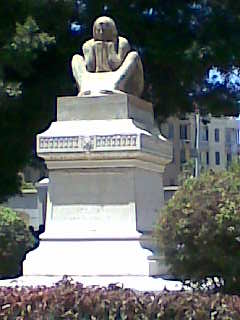
Statue by the famous Egyptian sculpter Mahmoud
Khalil in El Shalalat public garden |
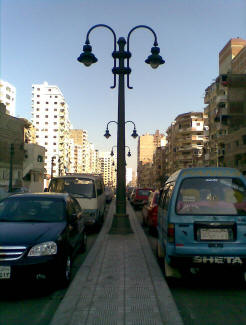 Street in Alexandria
Photo taken in President Mohamed Naguib street |
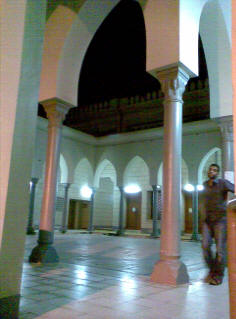
A Mosque in Alexandria
|
The shores of Alexandria on the Mediterranean extends to
more than 40 km conforming long sandy beaches attracting
thousands of local tourists from around Egypt in summer due
to the mild weather of the city most of the year.
Beaches stretch along the sea coast of Alexandria for
more than 40 km and provide a haven for local tourists or
residents looking for an escape from the hot summer weather.
If you stay at a hotel that have a private beach then you
will enjoy the water, sand and sun and you will have all the
facilities at the beach but if your hotel does not have a
private beach then you can go to other beaches. Beaches in
Alexandria are divided into three kinds:
- Free public beaches with no or few facilities. Be
prepared with all your requirement before you go to a
free beach including an umbrella and chairs if you can
although you might find a responsible person for renting
these.
- Paid to enter beaches: You pay for a ticket that
includes an umbrella, a table and chairs. The admission
fees are as follows (depending of the beach, prices are
in Egyptian pound which equals approximately US$ 0.18):
- L.E 2-3 / person
- L.E 4-5 / umbrella
- L.E 2-3 / chair
- L.E 2 / table
- There are some facilities on the beach like a
shower or toilet. You can also order food, drinks,
ice cream but you will pay for these.
- Private beaches: These belong to a community in some
parts of Alexandria like Agamy, Montazah or Maamoura but
you can pay an admission fee and get a ticket for around
L.E 10 ($1.8). You can either bring your own beach
requirements or rent them at the beach.
The weather in Alexandria follows almost the same pattern
of the Mediterranean north coast of African cities which is
characterized by its rainy warmth in Winter and hot
temperature that could reach 30°C
in Summer. Humidity is also high in Summer which gives a
feeling of hotter weather. People is Alexandria have the
privilege of having long sandy beaches along most parts of
the Mediterranean sea coast. These beaches are what makes
Alexandria a summer escape for most Egyptians living in
Cairo or other much hotter parts of Egypt.
Average temperature in Alexandria
|
Month |
Jan |
Feb |
Mar |
Apr |
May |
Jun |
Jul |
Aug |
Sep |
Oct |
Nov |
Dec |
Year |
| Average high °C
(°F) |
18.4
(65.1) |
19.3
(66.7) |
20.9
(69.6) |
24.0
(75.2) |
26.5
(79.7) |
28.6
(83.5) |
29.7
(85.5) |
30.4
(86.7) |
29.6
(85.3) |
27.6
(81.7) |
24.1
(75.4) |
20.1
(68.2) |
24.9
(76.8) |
| Daily mean °C
(°F) |
13.8
(56.8) |
14.3
(57.7) |
15.9
(60.6) |
18.7
(65.7) |
21.6
(70.9) |
24.5
(76.1) |
26.3
(79.3) |
26.8
(80.2) |
25.5
(77.9) |
22.7
(72.9) |
19.2
(66.6) |
15.4
(59.7) |
20.4
(68.7) |
| Average low °C
(°F) |
9.1
(48.4) |
9.3
(48.7) |
10.8
(51.4) |
13.4
(56.1) |
16.6
(61.9) |
20.3
(68.5) |
22.8
(73) |
23.1
(73.6) |
21.3
(70.3) |
17.8
(64) |
14.3
(57.7) |
10.6
(51.1) |
15.8
(60.4) |
We have prepared a special page for holiday costs in
Egypt at:
Quick links:
|